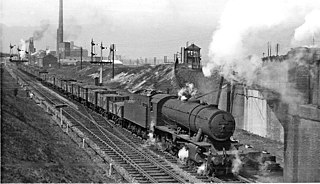Related Research Articles
Earl Fitzwilliam's private railway near Rotherham, South Yorkshire, was constructed in order to link the Earl's coal interests to the southeast of his Wentworth estate with the Greasbrough Canal, also owned by his estate, which gave an outlet to the River Dun (Don) Navigation.

Orgreave Colliery was a coal mine situated adjacent to the main line of the Manchester, Sheffield and Lincolnshire Railway about 5 miles (8 km) east of Sheffield and 3.5 miles (6 km) south west of Rotherham. The colliery is within the parish of Orgreave, from which it takes its name.
Rotherham Main Colliery was situated in Canklow, about 0.5 miles south of Rotherham town centre in the Rother Valley. The area was the site of an ancient crossing of the river set below the crag on which were Canklow Woods, an ancient woodland area.
New Stubbin Colliery was a coal mine situated in the township of Rawmarsh near Rotherham, South Yorkshire, England. The colliery was situated in a deep valley. Along one side at the top of the valley runs Haugh Road, Rawmarsh and on the other a lane known locally as “Greasbrough Tops”.
Orgreave Colliery platform was a workman's halt built to serve the miners working at Orgreave Colliery in South Yorkshire, England. These workmen's trains or "Paddy Mails" were operated between Sheffield Victoria and Treeton Colliery at shift change times being hauled along the main line to Orgreaves Colliery Sidings where the main line locomotive was exchanged for one belonging to the colliery company, usually "Rothervale No.6" which was fitted with vacuum brakes.

The Birley Collieries were a group of coal mines set in the Shire Brook Valley in south east Sheffield, South Yorkshire, England. They were connected to the railway system by a branch line from the Manchester, Sheffield and Lincolnshire Railway at Woodhouse East Junction, about 800 yards east of Woodhouse station.
The Sheffield Coal Company was a colliery owning and coal selling company with its head office situated in South Street, Sheffield, South Yorkshire, England.

Rother Vale Collieries were a group of coal producing pits originally in the Rother Valley parishes of Treeton, Woodhouse and Orgreave, nowadays on the south east Sheffield / Rotherham boundary, in South Yorkshire, England. In the early 20th century a new colliery at Thurcroft was developed.
Tinsley Park Collieries were a group of coal mines situated in the Tinsley / Darnall area to the east of the City of Sheffield, South Yorkshire, England.

Kiveton Park Colliery was a coal mine in the village of Kiveton Park, near Rotherham, South Yorkshire, England.
Waleswood Colliery was a coal mine situated between Swallownest and Wales Bar, near Rotherham, South Yorkshire, England. The colliery was adjacent to the Rotherham to Clowne road and the main line of the Manchester, Sheffield and Lincolnshire Railway about 2 miles east of Woodhouse.
Nunnery Colliery was a coal mine close to the city centre of Sheffield, South Yorkshire. The mining company, known as The Waverley Coal Company, also worked High Hazels Colliery about 3 miles (5 km) further east.

To develop coal seams in the area, the Sheffield Coal Company opened a new colliery between Swallownest and Beighton, at that time on the borders of Rotherham Rural District and Derbyshire but now just within the borough of Rotherham. The company, which became part of the United Steel Companies in 1937, already owned other collieries in the area, particularly the Birley Collieries and that at Aston Common, known as North Staveley Colliery.

Derwenthaugh Coke Works was a coking plant on the River Derwent near Swalwell. The works were built in 1928 on the site of the Crowley's Iron Works, which had at one time been the largest iron works in Europe. The coke works was closed and demolished in the late 1980s, and replaced by Derwenthaugh Park.
The Astley and Tyldesley Collieries Company formed in 1900 owned coal mines on the Lancashire Coalfield south of the railway in Astley and Tyldesley, then in the historic county of Lancashire, England. The company became part of Manchester Collieries in 1929 and some of its collieries were nationalised in 1947.
Tyldesley Coal Company was a coal mining company formed in 1870 in Tyldesley, on the Manchester Coalfield in the historic county of Lancashire, England that had its origins in Yew Tree Colliery, the location for a mining disaster that killed 25 men and boys in 1858.
Fletcher, Burrows and Company was a coal mining company that owned collieries and cotton mills in Atherton, Greater Manchester, England. Gibfield, Howe Bridge and Chanters collieries exploited the coal mines (seams) of the middle coal measures in the Manchester Coalfield. The Fletchers built company housing at Hindsford and a model village at Howe Bridge which included pithead baths and a social club for its workers. The company became part of Manchester Collieries in 1929. The collieries were nationalised in 1947 becoming part of the National Coal Board.

Manvers Main Colliery was a coal mine, sunk on land belonging to the Earl Manvers on the northern edge of Wath-upon-Dearne, between that town and Mexborough in the Dearne Valley, in the West Riding of Yorkshire, England. The regional headquarters and laboratories of British Coal were situated in the complex.
Beighton Junction is a set of railway junctions near Beighton on the border between Derbyshire and South Yorkshire, England.

The Burnley Coalfield is the most northerly portion of the Lancashire Coalfield. Surrounding Burnley, Nelson, Blackburn and Accrington, it is separated from the larger southern part by an area of Millstone Grit that forms the Rossendale anticline. Occupying a syncline, it stretches from Blackburn past Colne to the Yorkshire border where its eastern flank is the Pennine anticline.
References
East of Sheffield by Roger Milnes. "Forward" - The journal of the Great Central Railway Society, No.16, July 1984. ISSN 0141-4488 (This article also uses unpublished material researched for "East of Sheffield" from various sources including members of Woodhouse Local History Group, members of the Great Central Railway Society and others).